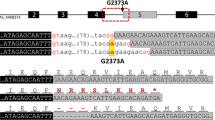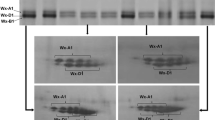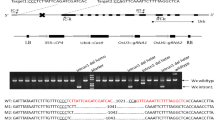Abstract
Waxy maize has little or very low content of amylose (<5 %) in grain starch and carries null mutations of the waxy (Wx) gene. With important uses as fresh maize or as an ingredient in food, textile, adhesive, and paper industries, two types of wx allele, wx-D7 and wx-D10, had been identified. In the present study, 10 accessions carrying neither wx-D7 nor wx-D10 allele were identified from a collection of 325 waxy maize accessions. The Wx locus of these 10 accessions was sequenced, but no potential causative mutation was detected. Further sequencing of the full-length complementary DNAs revealed that 6 of the 10 accessions had alternative splicing patterns while the other 4 had wild-type Wx transcripts. Among the six accessions, one generated transcripts identical to the wx-D7 allele, two had the same transcripts as the wx-D10 allele, another two generated transcripts with deletion of the 10th and the 11th exon, yet the other one produced transcripts of various lengths due to deletions from part of the 2nd exon to part of the 12th exon. The wx alleles with the above alternative splicing modes are referred to as wx-tD7, wx-tD10, wx-tD10-11, and wx-tD2-12, respectively. Real-time quantitative reverse-transcription polymerase chain reaction analysis of two waxy accessions that produced Wx transcripts showed significantly decreased expression, having only 47.3 and 3.6 % transcription level compared with B73. Sequence analysis of deletions in the transcripts with comparison with wild one showed short direct repeats at deletion endpoints, similar to reported signatures of DNA deletions. The waxy accessions present unique wx alleles for waxy maize breeding as well as for transcriptional regulation studies in plants.




Similar content being viewed by others
References
Buckler ES, Holland JB, Bradbury PJ, Acharya CB, Brown PJ, Browne C, Ersoz E, Flint-Garcia S, Garcia A, Glaubitz JC, Goodman MM, Harjes C, Guill K, Kroon DE, Larsson S, Lepak NK, Li H, Mitchell SE, Pressoir G, Peiffer JA, Rosas MO, Rocheford TR, Romay MC, Romero S, Salvo S, Sanchez Villeda H, da Silva HS, Sun Q, Tian F, Upadyayula N, Ware D, Yates H, Yu J, Zhang Z, Kresovich S, McMullen MD (2009) The genetic architecture of maize flowering time. Science 325(5941):714–718. doi:10.1126/science.1174276
Collins GN (1909) A new type of Indian corn from China. Bur Plant Ind (Bull) 161:1–30. doi:10.5962/bhl.title.37128
Collins GN (1920) Waxy maize from Upper Burma. Science 52(1333):48–51. doi:10.1126/science.52.1333.48
Ding XZ, Wang BG, Gao QH, Zhang Q, Yan GQ, Duan K, Huang JH (2009) Molecular diversity and differential expression of starch-synthesis genes in developing kernels of three maize inbreds. Plant Cell Rep 28(10):1487–1495. doi:10.1007/s00299-009-0748-5
Domon E, Fuijita M, Ishikawa N (2002) The insertion/deletion polymorphisms in the waxy gene of barley genetic resources from East Asia. Theor Appl Genet 104(1):132–138. doi:10.1007/s001220200016
Fan LJ, Quan LY, Leng XD, Guo XY, Hu WM, Ruan SL, Ma HS, Zeng MQ (2008) Molecular evidence for post-domestication selection in the waxy gene of Chinese waxy maize. Mol Breed 22(3):329–338. doi:10.1007/s11032-008-9178-2
Fan LJ, Bao JD, Wang Y, Yao JQ, Gui YJ, Hu WM, Zhu JQ, Zeng MQ, Li Y, Xu YB (2009) Post-domestication selection in the maize starch pathway. PLoS ONE 4(10):e7612. doi:10.1371/journal.pone.0007612
Fedoroff N, Wessler S, Shure M (1983) Isolation of the transposable maize controlling elements Ac and Ds. Cell 35(1):235–242. doi:10.1016/0092-8674(83)90226-X
Hirano HY, Sano Y (1991) Molecular characterization of the waxy locus of rice (Oryza sativa). Plant Cell Physiol 32(7):989–997
Huang YB, Rong TZ (1998) Genetic diversity and origin of Chinese waxy maize. Crop J S1:77–80 (in Chinese)
Klosgen RB, Gierl A, Schwarzsommer Z, Saedler H (1986) Molecular analysis of the waxy locus of Zea mays. Mol Biol Evol 203(2):237–244. doi:10.1007/BF00333960
Konishi S, Izawa T, Lin SY, Ebana K, Fukuta Y, Sasaki T, Yano M (2006) An SNP caused loss of seed shattering during rice domestication. Science 312(5778):1392–1396. doi:10.1126/science.1126410
Kuleshov NN (1954) Some peculiarities in the maize of Asia. Ann Mo Bot Gard 41:271–299. doi:10.2307/2394586
Lemos MC, Thakker RV (2008) Multiple endocrine neoplasia type 1 (MEN1): analysis of 1336 mutations reported in the first decade following identification of the gene. Hum Mutat 29:22–32. doi:10.1002/humu.20605
Liu J, Rong TZ, Li WC (2007) Mutation loci and intragenic selection marker of the granule-bound starch synthase gene in waxy maize. Mol Breed 20(2):93–102. doi:10.1007/s11032-006-9074-6
Marillonnet S, Wessler SR (1997) Retrotransposon insertion into the maize waxy gene results in tissue-specific RNA processing. Plant Cell 9(6):967–978. doi:10.1105/tpc.9.6.967
McIntyre CL, Drenth J, Gonzalez N, Henzell RG, Jordan DR (2008) Molecular characterization of the waxy locus in sorghum. Genome 51(7):524–533. doi:10.1139/G08-035
Nakamura T, Yamamori M, Hirano H, Hidaka S, Nagamine T (1995) Production of waxy (amylose-free) wheats. Mol Gen Genet 248(3):253–259. doi:10.1007/BF02191591
Okagaki RJ, Neuffer MG, Wessler SR (1991) A deletion common to two independently derived waxy mutations of maize. Genetics 128(2):425–431
Patron NJ, Smith AM, Fahy BF, Hylton CM, Naldrett MJ, Rossnagel BG, Denyer K (2002) The altered pattern of amylose accumulation in the endosperm of low-amylose barley cultivars is attributable to a single mutant allele of granule-bound starch synthase I with a deletion in the 5′-non-coding region. Plant Physiol 130(1):190–198. doi:10.1104/pp.005454
Polke JM, Laurá M, Pareyson D, Taroni F, Milani M, Bergamin G, Gibbons VS, Houlden H, Chamley SC, Blake J, DeVile C, Sandford R, Sweeney MG, Davis MB, Reilly MM (2011) Recessive axonal Charcot-Marie-Tooth disease due to compound heterozygous mitofusin 2 mutations. Neurology 77:168–173. doi:10.1212/WNL.0b013e3182242d4d
Reddy AS (2007) Alternative splicing of pre-messenger RNAs in plants in the genomic era. Annu Rev Plant Biol 58:267–294. doi:10.1146/annurev.arplant.58.032806.103754
Rozen S, Skaletsky H (2000) Primer3 on the WWW for general users and for biologist programmers. Methods Mol Biol 132:365–386. doi:10.1385/1-59259-192-2:365
Salvi S, Sponza G, Morgante M, Tomes D, Niu X, Fengler KA, Meeley R, Ananiev EV, Svitashev S, Bruggemann E, Li B, Hainey CF, Radovic S, Zaina G, Rafalski JA, Tingey SV, Miao GH, Phillips RL, Tuberosa R (2007) Conserved noncoding genomic sequences associated with a flowering-time quantitative trait locus in maize. PNAS 104(27):11376–11381. doi:10.1073/pnas.0704145104
Sambrook J, Russell DW (1989) Molecular cloning: a laboratory manual, 3rd edn. Cold Spring Harbor Laboratory Press, Cold Spring Harbor
Tian ML, Huang YB, Tan GX, Liu YJ, Rong TZ (2008) Sequence polymorphism of waxy genes in landraces of waxy maize from Southwest China. Acta Agron Sin 34(5):729–736 (in Chinese with an English abstract)
Varagona MJ, Purugganan M, Wessler SR (1992) Alternative splicing induced by insertion of retrotransposons into the maize waxy gene. Plant Cell 4(7):811–820. doi:10.1105/tpc.9.6.967
Wessler SR, Varagona MJ (1985) Molecular-basis of mutations at the waxy locus of maize: correlation with the fine structure genetic map. PNAS 82(12):4177–4181. doi:10.1073/pnas.82.12.4177
Wessler S, Tarpley A, Purugganan M, Spell M, Okagaki R (1990) Filler DNA is associated with spontaneous deletions in maize. PNAS 87(22):8731–8735. doi:10.1073/pnas.87.22.8731
Yong HJ, Zhang SH, Zhang DG, Li MS, Li XH, Hao ZF, Liu XX, Bai L, Xie CX (2009) Analysis of genetic diversity among 90 waxy corn landraces using fluorescent SSR markers. J Maize Sci 17(1):6–12 (in Chinese with an English abstract)
Acknowledgments
This work was supported by the National Basic Research Program of China (2011CB109306), the Zhejiang Provincial Natural Science Foundation of China (Y3080059), and the Project Based Personnel Exchange Program (PPP) of the China Scholarship Council and German Academic Exchange Service.
Author information
Authors and Affiliations
Corresponding author
Rights and permissions
About this article
Cite this article
Bao, Jd., Yao, Jq., Zhu, Jq. et al. Identification of glutinous maize landraces and inbred lines with altered transcription of waxy gene. Mol Breeding 30, 1707–1714 (2012). https://doi.org/10.1007/s11032-012-9754-3
Received:
Accepted:
Published:
Issue Date:
DOI: https://doi.org/10.1007/s11032-012-9754-3




